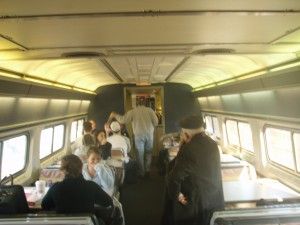Rail Series: Medium-speed train tracking costs less than high-speed rail
by CalWatchdog Staff | December 14, 2012 8:58 am
 [1]This is Part 4 of a series on Medium-Speed rail alternatives to California’s High-Speed Rail project. Click to read Part 1[2], Part 2[3], Part 3[4], Part 4[5], Part 5[6] and Part 6[7].
[1]This is Part 4 of a series on Medium-Speed rail alternatives to California’s High-Speed Rail project. Click to read Part 1[2], Part 2[3], Part 3[4], Part 4[5], Part 5[6] and Part 6[7].
Dec. 14, 2012
By Stan Brin
How much does it cost to lay an additional pair of tracks beside an existing line?
A lot, but not as much as you would think. According to spokesmen for the various railroads, it costs between $5 million and $10 million per mile to double-track an existing line, depending on the cost of land required for the additional tracks and the number of obstacles that have to be crossed.
Urban tracks tend cost on the high end due to land acquisition costs. Amtrak is currently working on a 10-mile, triple-tracking project in the highly urbanized San Gabriel Valley. The final cost is expected to be slightly above $10 million per mile.
Other sections will cost considerably less because the right of way and infrastructure are already in place. Twenty years ago, I lived less than 200 yards from a section of the Los Angeles-to-San Diego line as it was being doubled, but not one home or business was taken, or even disturbed. Railroad workers laid the new steel rails on their modern, concrete crossties right beside the old ones, and no one in the neighborhood even noticed.
That new section of double-tracking allowed faster and more frequent commuter traffic from Laguna Niguel in South Orange County into Los Angeles, but that’s it. From San Juan Capistrano south into San Diego County, a distance of roughly 60 miles, the rails are still essentially as they were in the days of buggy whips, gas lamps, bustles and derby hats.
How much would it cost to completely double-track this line? Split roughly evenly between urban and rural areas, this stretch is mostly level, with a lot of gullies. About half of it is federally owned, part of the Marine Corps Base Camp Pendleton, so there is no need to compensate private owners.
Let’s split the difference between the $5 and $10 million per-mile cost and guestimate that it might cost around $400 million to double-track the remaining 60 miles of single-track between Laguna Niguel and San Diego. Let’s err on the maximum to account for some extra sidings to allow non-stop travel, and adding four or five yards of sand to some public beach areas, and we have $600 million.
That’s well under one percent of the expected cost of the HSR to travel between Los Angeles and San Deigo, non-stop, downtown to downtown, at up to 100 miles per hour, free of traffic and the Transportation Safety Administration; and about a quarter of the cost of the 20-mile-long Alameda Corridor.
The Central Valley
Similar improvements of the 300-mile Central Valley route from Bakersfield to Sacramento would cost on the low end per mile since the route is entirely flat and mostly through farming country. And unlike that of the planned HSR, we can assume that much of the right of way is already owned by the railroad.
But let’s err again on the safe side and assume that passing through Fresno, Merced and other cities would cost $10 million per mile, and we still have a total cost of well under $2 billion. Let’s double it so that passenger trains wouldn’t have to compete with freight traffic, anywhere, and we have well under $4 billion.
All together, the cost of double-tracking the existing portion of the Sacramento to San Diego line is likely to be about double the cost of the Alameda Corridor.
And that’s perhaps 5 percent of the estimated cost of the HSR.
What the hell, let’s add another billion for extra tracks around Central Valley cities so that express trains can barrel through at full throttle the whole length of the line, without stopping, and we’re still well under 7 percent of the HSR.
- [Image]: http://www.calwatchdog.com/2012/12/14/rail-series-medium-speed-train-tracking-costs-less-than-high-speed-rail/olympus-digital-camera-18/
- Part 1: http://www.calwatchdog.com/2012/12/10/railroad-series-medium-speed-rail-runs-over-high-speed-rail/
- Part 2: http://www.calwatchdog.com/2012/12/12/rail-series-a-capitalist-solution-for-california-train-travel/
- Part 3: http://www.calwatchdog.com/2012/12/13/rail-series-single-track-bottleneck-slows-ca-trains/
- Part 4: http://www.calwatchdog.com/2012/12/14/rail-series-medium-speed-train-tracking-costs-less-than-high-speed-rail/
- Part 5: http://www.calwatchdog.com/2012/12/17/rail-series-surmounting-the-tehachapi-barrier/
- Part 6: http://www.calwatchdog.com/2012/12/18/rail-series-who-will-own-it-who-will-pay-for-it/
Source URL: https://calwatchdog.com/2012/12/14/rail-series-medium-speed-train-tracking-costs-less-than-high-speed-rail/